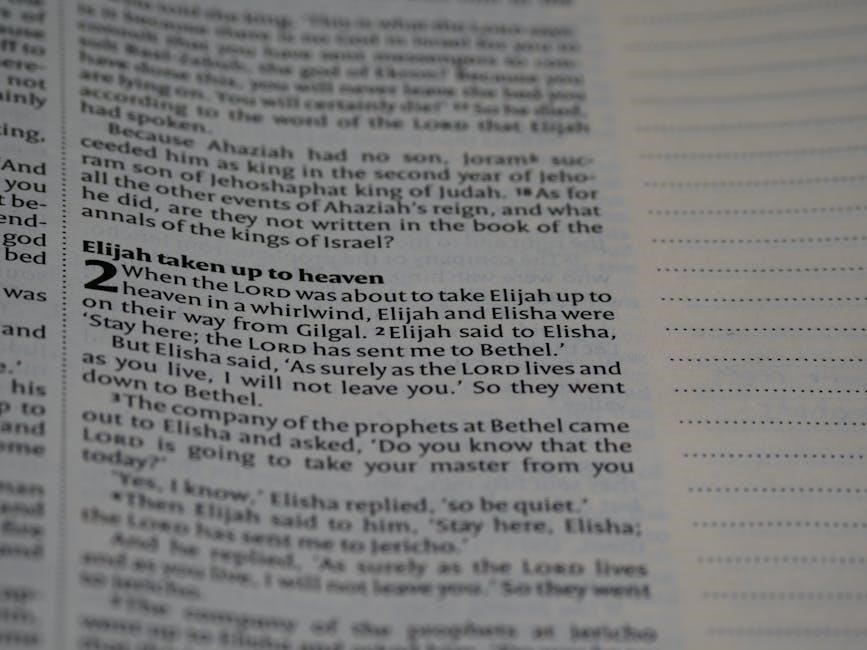This Martin Luther King Reading Comprehension PDF serves as an educational tool, offering passages, questions, and vocabulary exercises suitable for various grade levels, fostering critical thinking and engagement with historical content.
Overview of Reading Comprehension Materials
The Martin Luther King Reading Comprehension PDF offers a variety of educational resources designed to enhance students’ understanding of Dr. King’s life and legacy. These materials include passages about his role in the Civil Rights Movement, comprehension questions, and vocabulary exercises tailored to different grade levels. Worksheets are available for elementary, middle, and high school students, ensuring age-appropriate content. Interactive elements, such as word searches and puzzles, make learning engaging. The PDFs are suitable for both in-class and remote learning environments, with editable fields for student responses. Additionally, the materials incorporate key historical events, like the Montgomery Bus Boycott and the March on Washington, to provide context. This comprehensive approach fosters critical thinking and historical awareness while promoting literacy skills.
Importance of Reading Comprehension in Education
Reading comprehension is a cornerstone of education, enabling students to interpret and analyze texts effectively. It fosters critical thinking, vocabulary expansion, and the ability to engage with complex ideas. By using materials like the Martin Luther King Reading Comprehension PDF, students develop essential skills that apply across subjects. Improved comprehension enhances academic performance, supports independent learning, and prepares students for real-world challenges. Additionally, it encourages empathy and understanding of diverse perspectives, which is vital for social development. Cultivating strong reading skills early lays a foundation for lifelong learning and intellectual growth, making it a priority in educational curricula.

Martin Luther King Jr.: A Civil Rights Icon
Dr. Martin Luther King Jr. was a prominent civil rights leader who advocated for racial equality and social justice through nonviolent protest, inspiring transformative change in America.
Biographical Sketch of Martin Luther King Jr.
Martin Luther King Jr. was born on January 15, 1929, in Atlanta, Georgia. He became a prominent leader in the civil rights movement, advocating for racial equality and justice through nonviolent protest. King earned a doctoral degree in theology and led significant events like the Montgomery Bus Boycott and the March on Washington. His iconic “I Have a Dream” speech remains a powerful symbol of hope and equality. Assassinated on April 4, 1968, King’s legacy endures as a champion of human rights, inspiring global movements for justice and equality. His life and work continue to educate and motivate individuals through reading comprehension materials.
His Role in the Civil Rights Movement
Martin Luther King Jr. played a pivotal role in the civil rights movement, leading nonviolent protests and advocating for racial equality. He spearheaded the Montgomery Bus Boycott, which ended segregation in public transportation, and delivered his iconic “I Have a Dream” speech during the March on Washington. King’s leadership and eloquence united people across the nation, pushing for legislative changes like the Civil Rights Act and Voting Rights Act. His commitment to peaceful resistance inspired countless activists and continues to influence social justice movements globally. Through his efforts, King became a symbol of hope and equality, leaving a lasting impact on American history and civil rights advancements.

Purpose of Martin Luther King Reading Comprehension Exercises
These exercises aim to enhance historical knowledge, develop critical thinking, and promote engagement with Dr. King’s legacy, fostering understanding of his impact on civil rights and equality.
Enhancing Historical Knowledge
The Martin Luther King Reading Comprehension PDF provides students with detailed passages about Dr. King’s life, his role in the Civil Rights Movement, and key historical events. These materials highlight his birth in Atlanta, education, and leadership in movements like the Montgomery Bus Boycott and the March on Washington. By focusing on these events, students gain a deeper understanding of the struggles and triumphs of the civil rights era. The PDF also includes excerpts from his speeches, such as the “I Have a Dream” speech, allowing students to analyze their impact. This resource helps students connect historical events to contemporary issues, fostering a comprehensive grasp of Dr. King’s legacy and its relevance today. The exercises are designed to be both educational and engaging, ensuring that historical knowledge is accessible and meaningful for learners of all ages.
Developing Critical Thinking Skills
The Martin Luther King Reading Comprehension PDF is designed to foster critical thinking by engaging students in analyzing passages about Dr. King’s life and legacy. The materials include comprehension questions that encourage students to interpret and evaluate information, moving beyond simple recall. Vocabulary exercises also promote deeper understanding by challenging students to use context clues and synthesize meanings. Interactive elements, such as word searches and puzzles, further enhance analytical skills while maintaining student engagement. By incorporating these features, the PDF helps students develop the ability to think critically about historical events and their significance, preparing them to apply these skills in real-world contexts and fostering a deeper appreciation for Dr. King’s impact on society.
Promoting Engagement with Historical Figures
Promoting Engagement with Historical Figures
The Martin Luther King Reading Comprehension PDF actively engages students with Dr. King’s story, fostering a personal connection to his role in history. By presenting his life and achievements through relatable passages, the material sparks curiosity and interest. Interactive elements, such as comprehension questions and vocabulary exercises, encourage students to delve deeper into his contributions to the Civil Rights Movement. This approach not only enhances understanding but also inspires students to reflect on the relevance of Dr. King’s message in today’s world. The PDF’s design ensures that learners of all ages can connect with Dr. King’s legacy, making history accessible and meaningful. By engaging with his story, students develop a lasting appreciation for his impact on society and the importance of standing up for justice.

Structure of Martin Luther King Reading Comprehension PDF
The PDF features passages about MLK, comprehension questions, vocabulary exercises, and interactive elements, providing a comprehensive structure that enhances understanding and engagement with Dr. King’s life and legacy.
Passages About Martin Luther King Jr.
The passages within the PDF provide a detailed overview of Martin Luther King Jr.’s life, highlighting his role in the Civil Rights Movement. They cover key events such as the Montgomery Bus Boycott and the March on Washington, where his iconic “I Have a Dream” speech was delivered. These passages are written at varying reading levels to accommodate students from elementary to high school, ensuring accessibility for all learners. The texts emphasize Dr. King’s commitment to nonviolent protest and his vision for equality, offering students a comprehensive understanding of his impact on American history. The passages are both informative and engaging, making them ideal for fostering historical knowledge and critical thinking skills in students.
Comprehension Questions
The PDF includes a variety of comprehension questions designed to assess understanding of the passages about Martin Luther King Jr. These questions are tailored to different grade levels, ensuring accessibility for elementary, middle, and high school students. They range from multiple-choice and true/false to open-ended questions, prompting students to analyze key events, such as the Montgomery Bus Boycott and the March on Washington. Questions focus on MLK’s beliefs, his role in the Civil Rights Movement, and the impact of his speeches. Additionally, they encourage critical thinking about his legacy and its relevance today. These exercises help students develop reading skills while deepening their understanding of MLK’s contributions to history.
Vocabulary Exercises
The Martin Luther King Reading Comprehension PDF incorporates vocabulary exercises to enhance students’ language skills. These exercises feature key terms related to MLK’s life and the Civil Rights Movement, such as “equality,” “segregation,” and “nonviolent.” Activities include matching words to definitions, filling in the blanks, and identifying synonyms or antonyms. For younger students, word searches and crossword puzzles are provided to make learning engaging. The exercises are grade-appropriate, with simpler terms for elementary students and more complex vocabulary for high school levels. They aim to improve decoding skills, contextual understanding, and the ability to use vocabulary effectively in discussions about MLK’s legacy and historical events. Interactive elements make these exercises both educational and enjoyable for all learners.
Interactive Elements for Student Engagement
The Martin Luther King Reading Comprehension PDF includes interactive elements to captivate students and deepen their understanding. Features like clickable buttons, drag-and-drop activities, and audio clips of MLK’s speeches make learning dynamic. Fillable fields allow students to type responses directly into the PDF, while hyperlinks provide access to additional resources and videos. For remote learners, interactive PDFs enable real-time feedback and collaboration. Word searches and crossword puzzles add a fun aspect, encouraging participation. These elements cater to diverse learning styles, making the content more accessible and engaging for students of all ages and skill levels, fostering a more immersive educational experience focused on MLK’s life and legacy.

Grade-Level Appropriateness
The Martin Luther King Reading Comprehension PDF offers materials tailored for elementary, middle, and high school students, ensuring age-appropriate content that aligns with varying skill levels and curriculum needs.
Elementary Grade Materials

Elementary grade materials in the Martin Luther King Reading Comprehension PDF are designed for young learners, featuring simple passages and engaging activities. These resources include easy-to-read texts about MLK’s life, basic vocabulary exercises, and fun tasks like word searches. The content is tailored to introduce students to key concepts of equality and kindness. Colorful illustrations and relatable language make learning enjoyable. Worksheets are available for 1st to 3rd grades, ensuring age-appropriate challenges. Activities focus on building foundational reading skills while fostering an understanding of MLK’s importance. These materials are both educational and entertaining, helping elementary students connect with history in an accessible way, while aligning with curriculum standards for early childhood education.
Middle School Resources
Middle school resources in the Martin Luther King Reading Comprehension PDF cater to older students, offering more detailed passages and challenging questions. These materials align with curriculum standards, focusing on MLK’s role in the Civil Rights Movement and his impact on society. Students engage with historical events like the Montgomery Bus Boycott and the March on Washington through reading and analysis. Vocabulary exercises and critical thinking prompts encourage deeper understanding. Interactive elements, such as timelines and discussion questions, enhance learning. The PDF is designed to be user-friendly, with clear formatting and multi-device compatibility, making it accessible for both in-class and remote learning environments. These resources help middle schoolers develop strong comprehension and analytical skills while connecting with MLK’s legacy.

High School Level Exercises
The high school level exercises in the Martin Luther King Reading Comprehension PDF are designed to challenge advanced students with complex passages and thought-provoking questions. These resources focus on MLK’s significant contributions to the Civil Rights Movement, emphasizing his speeches, leadership, and historical impact. Students analyze key events like the Montgomery Bus Boycott and the March on Washington, developing a deeper understanding of their significance. The exercises also include critical thinking prompts, encouraging students to reflect on MLK’s legacy and its relevance today. Vocabulary exercises target advanced terms, while comprehension questions require detailed analysis. The PDF’s interactive features, such as editable fields and multi-device compatibility, support remote and in-class learning, making it an ideal tool for high school education.

Historical Context in Reading Materials
The reading materials provide historical context, incorporating key events such as the Montgomery Bus Boycott and the March on Washington, highlighting their impact on the Civil Rights Movement and Martin Luther King Jr.’s role.
The Montgomery Bus Boycott
The Montgomery Bus Boycott, sparked by Rosa Parks’ refusal to give up her seat in 1955, became a pivotal moment in the Civil Rights Movement. Lasting 381 days, the boycott ended with the U.S. Supreme Court ruling that segregation on public buses was unconstitutional. Led by Dr. Martin Luther King Jr., this nonviolent protest demonstrated the power of unity and peaceful resistance. The boycott not only desegregated buses but also launched King’s national prominence as a civil rights leader. Reading materials detail the events, highlighting the courage of participants and the broader impact on the fight for equality. This historical context is essential for understanding King’s legacy and the movement’s progression.
The March on Washington
The March on Washington, held in 1963, was a landmark event in the Civil Rights Movement, where hundreds of thousands gathered to advocate for racial equality. Dr. Martin Luther King Jr. delivered his iconic “I Have a Dream” speech, calling for an end to segregation and racial injustice. The march led to significant legislative changes, including the Civil Rights Act of 1964. Reading comprehension materials highlight the event’s historical significance, King’s powerful oratory, and its enduring impact on American society. These resources help students grasp the importance of peaceful protest and the ongoing struggle for equality, making it a vital part of educational curricula focused on King’s contributions to civil rights history.
Key Speeches and Their Impact
Martin Luther King Jr.’s speeches are central to understanding his role in the Civil Rights Movement. His iconic “I Have a Dream” speech, delivered during the March on Washington, is a cornerstone of American history, advocating for racial equality and justice. Another pivotal speech, “Mountaintop,” highlighted his vision for a unified future. These speeches not only inspired mass movements but also shaped legislative changes, such as the Civil Rights Act of 1964. Reading comprehension exercises often focus on these speeches, helping students analyze their historical context, emotional appeal, and lasting influence. By studying these texts, learners gain a deeper understanding of King’s leadership and the power of rhetoric in driving social change, making these speeches essential components of educational materials about his life and legacy.

Digital Features of the PDF
The PDF includes interactive elements, editable fields for student responses, and compatibility across devices, enhancing accessibility and engagement for remote and in-class learning environments.
Interactive PDFs for Remote Learning
Interactive PDFs for remote learning are a valuable resource, enabling students to engage with Martin Luther King Jr.’s story digitally. These PDFs are designed to be accessible across various devices, ensuring flexibility for learners. Features like editable fields allow students to type responses directly, making it easy to submit assignments online. The interactive elements, such as clickable buttons and hyperlinks, enhance engagement and provide a dynamic learning experience. Teachers can share these PDFs effortlessly, making them ideal for virtual classrooms. This format supports remote education by offering a structured way to learn about MLK’s life and legacy while developing essential reading comprehension skills. The convenience and interactivity of these PDFs make them a powerful tool for modern education.
Editable Fields for Student Responses
Editable fields in Martin Luther King reading comprehension PDFs provide students with a convenient way to input their answers directly within the document. These fields are easy to navigate and allow learners to type their responses clearly and legibly. Teachers can quickly review and provide feedback, enhancing the learning process. The digital format eliminates the need for printing and scanning, making it eco-friendly and efficient. Editable fields also ensure that students’ work remains organized and easily accessible for future reference. This feature is particularly beneficial for remote learning, as it streamlines submission and grading processes. It fosters a seamless interaction between students and educators, promoting a more engaging and efficient learning experience.
Multi-Device Compatibility
Martin Luther King reading comprehension PDFs are designed to be accessible across multiple devices, ensuring flexibility for learners of all ages. Whether students use desktops, tablets, or mobile devices, the PDFs maintain their layout and functionality seamlessly. This compatibility allows teachers to assign materials confidently, knowing that students can access them from any device. Additionally, the PDFs are optimized for both online and offline viewing, making them suitable for remote learning environments. Multi-device compatibility enhances the accessibility of educational resources, enabling students to engage with Martin Luther King’s life and legacy from anywhere. This feature promotes inclusivity and ensures that learning is uninterrupted by technical limitations, making the content universally accessible.

Worksheets and Activity Ideas
Engage students with Martin Luther King Jr.-themed worksheets, including word searches, vocabulary puzzles, and reading comprehension exercises to foster learning through interactive and creative activities.
Reading and Listening Comprehension Exercises
These exercises combine reading passages with listening activities to enhance understanding of Martin Luther King Jr.’s life and legacy. Students read texts about his role in the Civil Rights Movement, then answer questions to assess comprehension. Listening exercises include audio clips of key speeches, such as the “I Have a Dream” speech, followed by questions to test auditory understanding. These activities promote both literacy and critical thinking skills, engaging students with historical content. Additionally, vocabulary puzzles and matching games reinforce language development while connecting to MLK’s message. These exercises are designed to be interactive and educational, making learning about MLK both fun and impactful for students of all ages.
Word Search and Vocabulary Puzzles
Word searches and vocabulary puzzles are engaging tools to reinforce learning about Martin Luther King Jr. These activities feature key terms related to his life, such as “equality,” “peace,” and “justice.” Students locate and circle words in a grid, fostering familiarity with relevant vocabulary. Crossword puzzles and anagrams further enhance language skills, encouraging critical thinking. These exercises are designed for various grade levels, ensuring accessibility and fun. By integrating these puzzles with reading comprehension, students gain a deeper understanding of MLK’s legacy while improving their lexical knowledge. Such activities make learning interactive and enjoyable, helping students connect with historical content in a creative way.
The Martin Luther King Reading Comprehension PDF is a valuable educational resource, fostering understanding of MLK’s legacy while enhancing reading and critical thinking skills.
The Martin Luther King Reading Comprehension PDF offers a comprehensive learning experience, combining reading passages, comprehension questions, and vocabulary exercises to enhance understanding of MLK’s role in the Civil Rights Movement. It provides interactive elements, engaging students and promoting deeper historical insight. The resource supports remote learning with editable fields and multi-device compatibility, ensuring accessibility for all learners. By focusing on critical thinking and historical context, it fosters a deeper appreciation of MLK’s legacy. The PDF is suitable for various grade levels, making it a versatile tool for educators. Its combination of educational value and engaging activities ensures students gain both knowledge and critical thinking skills, while encouraging further exploration of historical figures and events.
Encouraging Further Learning
The Martin Luther King Reading Comprehension PDF is designed to inspire students to explore beyond the text. By incorporating engaging activities and thought-provoking questions, it motivates learners to delve deeper into MLK’s legacy and the Civil Rights Movement. The inclusion of supplementary materials, such as discussion guides and creative projects, encourages students to connect with the content on a personal level. Additionally, the PDF provides resources for further reading, enabling students to expand their understanding of historical events and key figures. This approach fosters a lifelong love of learning and promotes a deeper appreciation for the significance of MLK’s contributions to society.
